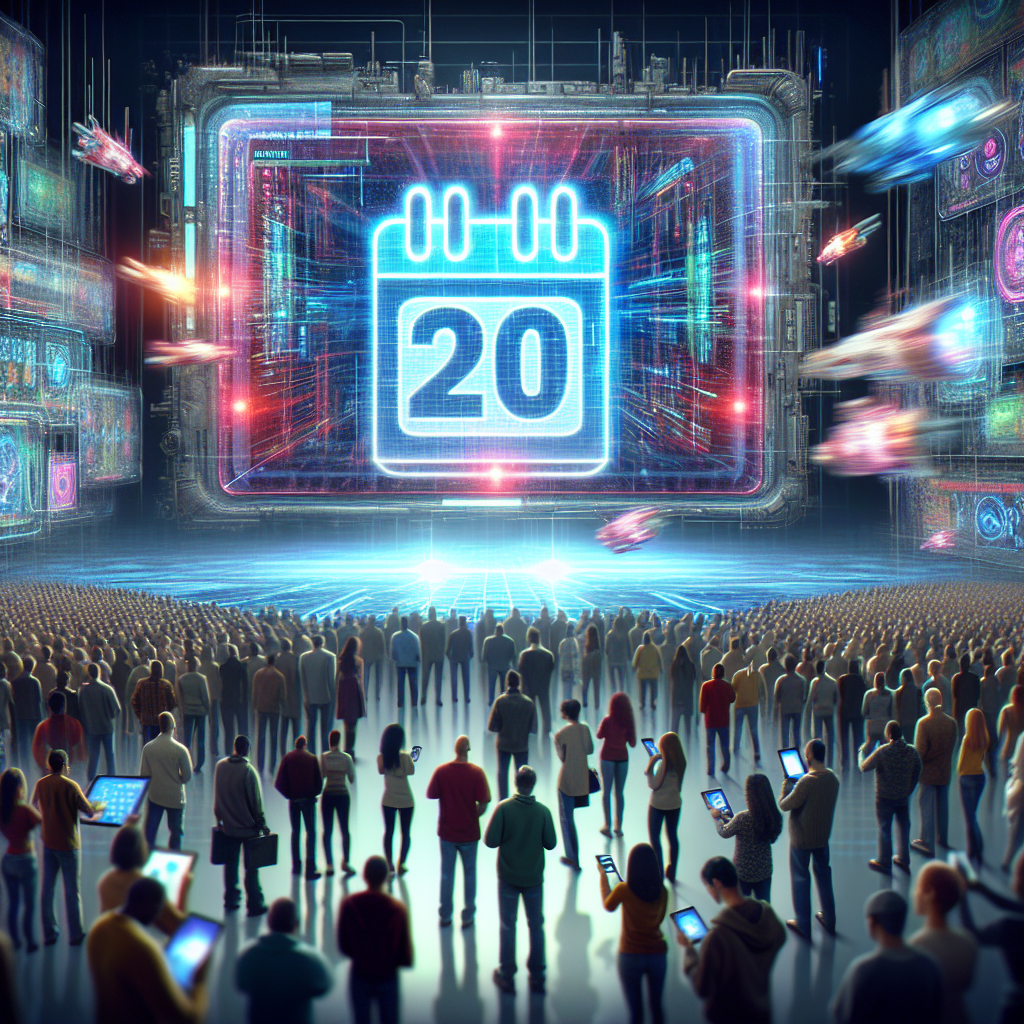“Unleashing Tomorrow: Nvidia’s Visionary Innovations Await on Nov. 20”
Introduction
Nvidia’s upcoming announcements on November 20 are highly anticipated within the tech industry, as the company is expected to unveil a range of innovations and advancements that could significantly impact various sectors. Known for its cutting-edge graphics processing units (GPUs) and contributions to artificial intelligence (AI), Nvidia is likely to showcase new hardware and software solutions that enhance performance and efficiency. Speculation surrounds potential updates to their GPU lineup, advancements in AI technology, and developments in gaming and data center solutions. As Nvidia continues to push the boundaries of technology, these announcements are poised to offer insights into the future of computing and digital experiences.
New GPU Architectures: What Innovations to Expect
As the tech world eagerly anticipates Nvidia’s upcoming announcements on November 20, the focus is squarely on the potential unveiling of new GPU architectures. Nvidia, a leader in the graphics processing unit industry, has consistently pushed the boundaries of what is possible in computing technology. With each new release, the company has set higher standards for performance, efficiency, and innovation. Therefore, the forthcoming announcements are expected to continue this trend, offering groundbreaking advancements that could redefine the landscape of GPU technology.
One of the most anticipated aspects of Nvidia’s announcements is the introduction of new architectures that promise to enhance computational power and efficiency. Historically, Nvidia’s architectural innovations have significantly impacted various sectors, from gaming and professional graphics to artificial intelligence and data centers. The upcoming architectures are expected to build on this legacy, potentially introducing novel features that could revolutionize how GPUs are utilized across different applications. For instance, there is speculation that Nvidia might focus on improving ray tracing capabilities, a technology that simulates the physical behavior of light to produce highly realistic images. Enhanced ray tracing could lead to more immersive gaming experiences and more accurate visual simulations in professional settings.
In addition to performance enhancements, energy efficiency is likely to be a key focus of Nvidia’s new architectures. As the demand for more powerful GPUs grows, so does the need for energy-efficient solutions that can deliver high performance without excessive power consumption. Nvidia has previously demonstrated its commitment to sustainability through initiatives like the development of more efficient cooling systems and power management technologies. The upcoming announcements may reveal further advancements in this area, potentially introducing GPUs that offer superior performance while minimizing their environmental impact.
Moreover, Nvidia’s new architectures could also bring about significant improvements in AI and machine learning capabilities. The company’s GPUs are already widely used in these fields, thanks to their ability to handle large-scale computations and process vast amounts of data quickly. With the rise of AI-driven applications and the increasing complexity of machine learning models, there is a growing need for GPUs that can deliver even greater computational power. Nvidia’s upcoming architectures might address this need by incorporating specialized cores or enhanced processing units designed specifically for AI workloads, thereby enabling faster and more efficient training of machine learning models.
Furthermore, the integration of advanced connectivity features could be another highlight of Nvidia’s new architectures. As data-intensive applications become more prevalent, the ability to transfer data quickly and efficiently between devices is crucial. Nvidia may introduce innovations that enhance data transfer speeds and reduce latency, potentially through the adoption of new interface standards or the development of proprietary technologies. Such advancements could have significant implications for industries that rely on real-time data processing, such as autonomous vehicles and high-frequency trading.
In conclusion, Nvidia’s upcoming announcements on November 20 are poised to introduce new GPU architectures that promise to deliver substantial innovations across various domains. From enhanced performance and energy efficiency to improved AI capabilities and advanced connectivity features, these developments could set new benchmarks for the industry. As we await the official unveiling, the anticipation continues to build, with the potential for Nvidia to once again redefine the future of GPU technology.
AI Advancements: Nvidia’s Next Steps in Artificial Intelligence
As the world eagerly anticipates Nvidia’s upcoming announcements on November 20, the focus is squarely on the company’s next steps in artificial intelligence. Nvidia, a leader in the AI and graphics processing unit (GPU) industry, has consistently pushed the boundaries of technology, and this event promises to be no exception. With AI becoming increasingly integral to various sectors, Nvidia’s advancements are likely to have far-reaching implications.
To begin with, Nvidia’s innovations in AI have historically centered around their powerful GPUs, which are essential for training complex machine learning models. These GPUs have been the backbone of many AI applications, from autonomous vehicles to advanced robotics. As we look forward to the November 20 announcements, it is expected that Nvidia will unveil new GPU architectures that promise even greater efficiency and performance. Such advancements could significantly reduce the time and computational power required for AI model training, thereby accelerating the pace of AI development across industries.
Moreover, Nvidia’s recent focus on software solutions, such as the Nvidia AI Enterprise suite, suggests that the company is keen on providing comprehensive tools that cater to the entire AI workflow. This suite has been instrumental in simplifying AI deployment for businesses, offering a range of tools that facilitate everything from data preparation to model deployment. On November 20, we might see enhancements to this suite, potentially introducing new features that further streamline AI processes. These improvements could make AI more accessible to companies that lack extensive technical expertise, thereby democratizing AI technology.
In addition to hardware and software, Nvidia’s role in AI research cannot be overlooked. The company has been at the forefront of developing cutting-edge AI models and algorithms, often collaborating with leading research institutions. As such, the upcoming announcements may include breakthroughs in AI research that could redefine current capabilities. For instance, advancements in natural language processing or computer vision could open new avenues for AI applications, enhancing everything from customer service chatbots to medical imaging technologies.
Furthermore, Nvidia’s commitment to sustainability and energy efficiency is likely to be a key theme in their announcements. As AI models grow in complexity, the energy required to train and deploy them has become a significant concern. Nvidia has been proactive in addressing this issue, developing technologies that reduce the carbon footprint of AI operations. On November 20, we can expect Nvidia to introduce new solutions that align with global sustainability goals, potentially setting new standards for energy-efficient AI technologies.
Finally, Nvidia’s strategic partnerships and acquisitions could also play a pivotal role in their upcoming announcements. The company has a history of forming alliances that enhance its technological capabilities and market reach. Whether through collaborations with cloud service providers or acquisitions of AI startups, Nvidia’s strategic moves often signal the direction of their future innovations. Therefore, any new partnerships announced on November 20 could provide valuable insights into Nvidia’s long-term vision for AI.
In conclusion, Nvidia’s upcoming announcements on November 20 are poised to make significant waves in the AI landscape. With potential advancements in GPU technology, software solutions, AI research, sustainability, and strategic partnerships, Nvidia continues to solidify its position as a leader in artificial intelligence. As the world watches with anticipation, the implications of these announcements are likely to resonate across industries, shaping the future of AI in profound ways.
Gaming Enhancements: How Nvidia Plans to Revolutionize Gaming
As the gaming industry continues to evolve at a rapid pace, Nvidia remains at the forefront of technological advancements, consistently pushing the boundaries of what is possible in gaming. With the upcoming announcements scheduled for November 20, enthusiasts and industry experts alike are eagerly anticipating what Nvidia has in store. The company’s commitment to revolutionizing gaming is evident in its continuous efforts to enhance graphics, improve performance, and introduce innovative features that redefine the gaming experience.
One of the most anticipated aspects of Nvidia’s announcements is the potential unveiling of new graphics processing units (GPUs). Nvidia’s GPUs have long been the gold standard in the industry, known for their exceptional performance and cutting-edge technology. The introduction of a new line of GPUs could signify a leap forward in terms of processing power and efficiency, enabling gamers to experience more realistic graphics and smoother gameplay. This is particularly relevant as game developers increasingly strive to create immersive worlds that demand high computational power.
In addition to hardware advancements, Nvidia is expected to focus on software innovations that enhance gaming experiences. The company’s deep learning super sampling (DLSS) technology has already made significant strides in improving game performance by using artificial intelligence to upscale lower-resolution images in real-time. This not only enhances visual fidelity but also allows for higher frame rates without compromising quality. It is plausible that Nvidia will introduce further refinements to DLSS or unveil new AI-driven technologies that will continue to optimize gaming performance.
Moreover, Nvidia’s announcements may also touch upon the integration of ray tracing technology, which has become a game-changer in rendering realistic lighting and shadows. Ray tracing has been a focal point in recent years, and Nvidia’s advancements in this area have set a new standard for visual realism in gaming. As developers increasingly adopt ray tracing in their games, Nvidia’s potential enhancements could make this technology more accessible and efficient, allowing a broader range of gamers to experience its benefits.
Furthermore, Nvidia’s commitment to cloud gaming is another area where significant developments are anticipated. The company’s GeForce Now service has already made strides in bringing high-quality gaming experiences to users without the need for powerful local hardware. As cloud gaming continues to gain traction, Nvidia’s announcements may include improvements to this service, such as expanded game libraries, reduced latency, and enhanced streaming quality. These advancements could further solidify Nvidia’s position as a leader in the cloud gaming space.
In addition to these technical advancements, Nvidia’s announcements may also address collaborations with game developers and other industry partners. Such partnerships are crucial in ensuring that new technologies are effectively integrated into upcoming game titles, providing gamers with seamless and optimized experiences. By working closely with developers, Nvidia can ensure that its innovations are utilized to their fullest potential, ultimately benefiting the gaming community as a whole.
As the date of Nvidia’s announcements approaches, the anticipation within the gaming community continues to build. The potential for groundbreaking advancements in both hardware and software promises to elevate gaming experiences to new heights. Whether through enhanced graphics, improved performance, or innovative features, Nvidia’s commitment to revolutionizing gaming remains unwavering. As gamers and industry professionals eagerly await November 20, the future of gaming looks brighter than ever, with Nvidia poised to lead the charge into a new era of technological excellence.
Partnerships and Collaborations: Strategic Moves by Nvidia

Nvidia, a leader in the field of graphics processing and artificial intelligence, is poised to make significant announcements on November 20, which are expected to highlight strategic partnerships and collaborations. These alliances are crucial for Nvidia as they continue to expand their influence across various sectors, including gaming, data centers, and autonomous vehicles. As the tech world eagerly anticipates these announcements, it is essential to understand the potential impact of these collaborations on Nvidia’s future trajectory and the broader technology landscape.
In recent years, Nvidia has demonstrated a keen ability to forge partnerships that enhance its technological capabilities and market reach. For instance, its collaboration with major cloud service providers has allowed Nvidia to integrate its powerful GPUs into cloud infrastructures, thereby enabling businesses to leverage advanced AI and machine learning capabilities. This strategic move not only solidifies Nvidia’s position in the cloud computing market but also opens up new avenues for innovation and growth.
Moreover, Nvidia’s partnerships extend beyond the realm of cloud computing. The company has been actively collaborating with automotive manufacturers to advance the development of autonomous vehicles. By providing cutting-edge AI technology and high-performance computing solutions, Nvidia is playing a pivotal role in shaping the future of transportation. These collaborations are expected to be a focal point of the upcoming announcements, as Nvidia continues to push the boundaries of what is possible in the automotive industry.
In addition to its work in cloud computing and autonomous vehicles, Nvidia has also been making strides in the gaming industry. The company’s GPUs are renowned for their performance and efficiency, making them a favorite among gamers and developers alike. Nvidia’s partnerships with game developers and hardware manufacturers have been instrumental in driving the adoption of its technologies, such as ray tracing and DLSS, which enhance the gaming experience. As Nvidia prepares to unveil new collaborations, the gaming community is keen to see how these partnerships will further elevate the gaming landscape.
Furthermore, Nvidia’s strategic moves are not limited to technology partnerships. The company has also been actively engaging with academic institutions and research organizations to foster innovation and drive advancements in AI and machine learning. By collaborating with leading researchers and scientists, Nvidia is not only contributing to the development of cutting-edge technologies but also ensuring that it remains at the forefront of AI research. These collaborations are likely to be highlighted in the upcoming announcements, showcasing Nvidia’s commitment to advancing the field of AI.
As we look forward to November 20, it is clear that Nvidia’s strategic partnerships and collaborations are central to its growth strategy. These alliances enable Nvidia to leverage external expertise and resources, thereby enhancing its technological capabilities and expanding its market reach. Moreover, by aligning itself with key players across various industries, Nvidia is well-positioned to capitalize on emerging trends and opportunities.
In conclusion, Nvidia’s upcoming announcements are expected to underscore the importance of strategic partnerships and collaborations in driving the company’s success. As Nvidia continues to innovate and expand its influence, these alliances will play a crucial role in shaping the future of technology. The tech world will be watching closely on November 20, eager to see how Nvidia’s strategic moves will impact the industry and pave the way for new advancements.
Software Updates: Enhancing Performance and Capabilities
As the tech world eagerly anticipates Nvidia’s upcoming announcements on November 20, attention is particularly focused on the software updates that promise to enhance performance and capabilities across their product range. Nvidia, a leader in graphics processing technology, has consistently pushed the boundaries of what is possible in both hardware and software. This upcoming event is expected to continue that tradition, offering innovations that could redefine user experiences in gaming, artificial intelligence, and professional visualization.
One of the most anticipated aspects of Nvidia’s announcements is the potential for updates to their GeForce Experience software. This platform, which optimizes gaming performance and provides seamless streaming capabilities, is a cornerstone for gamers worldwide. With the rapid evolution of gaming technology, Nvidia is likely to introduce features that leverage the power of their latest GPUs, such as the RTX 40 series. These updates could include enhanced ray tracing capabilities, improved AI-driven graphics enhancements, and more efficient power management, all of which would contribute to a more immersive and responsive gaming experience.
In addition to gaming, Nvidia’s software updates are expected to have significant implications for artificial intelligence applications. The company’s CUDA platform, which provides a parallel computing architecture, is integral to AI research and development. Enhancements to CUDA could lead to more efficient processing of complex algorithms, thereby accelerating advancements in machine learning and deep learning. This would not only benefit researchers and developers but also have far-reaching effects on industries such as healthcare, finance, and autonomous vehicles, where AI is increasingly becoming a critical component.
Moreover, Nvidia’s commitment to professional visualization is likely to be reflected in updates to their Omniverse platform. This collaborative environment allows creators to work together in real-time, regardless of their physical location. By integrating new tools and features, Nvidia could further streamline workflows for industries such as film production, architecture, and design. Enhancements in real-time rendering, simulation, and virtual reality capabilities would empower professionals to push the limits of creativity and innovation.
Furthermore, Nvidia’s software updates are expected to address the growing demand for energy-efficient computing solutions. As sustainability becomes a priority across the tech industry, Nvidia is likely to introduce optimizations that reduce power consumption without compromising performance. This could involve advancements in dynamic voltage and frequency scaling, as well as improvements in thermal management. Such updates would not only benefit individual users but also contribute to broader environmental goals by reducing the carbon footprint of data centers and other large-scale computing operations.
In conclusion, Nvidia’s upcoming announcements on November 20 are poised to deliver significant software updates that enhance performance and capabilities across various domains. By focusing on gaming, artificial intelligence, professional visualization, and energy efficiency, Nvidia continues to demonstrate its commitment to innovation and excellence. As these updates are unveiled, they will undoubtedly set new standards in the tech industry, offering users unprecedented levels of performance and functionality. As we await these developments, it is clear that Nvidia remains at the forefront of technological advancement, shaping the future of computing in ways that were once thought impossible.
Sustainability Initiatives: Nvidia’s Commitment to Green Technology
Nvidia, a leader in the technology industry, is set to make significant announcements on November 20, with a particular focus on sustainability initiatives. As the world increasingly turns its attention to environmental concerns, Nvidia’s commitment to green technology is both timely and essential. The company’s efforts to integrate sustainable practices into its operations and product development are not only a response to global environmental challenges but also a strategic move to align with the growing demand for eco-friendly technology solutions.
One of the key areas where Nvidia is expected to make strides is in the energy efficiency of its products. Graphics processing units (GPUs), which are central to Nvidia’s offerings, are known for their high energy consumption. However, Nvidia has been investing in research and development to create GPUs that deliver high performance while minimizing energy use. This balance is crucial as the demand for powerful computing continues to rise, particularly in sectors such as artificial intelligence, gaming, and data centers. By improving the energy efficiency of its products, Nvidia not only reduces its carbon footprint but also provides its customers with cost-effective solutions that align with their own sustainability goals.
In addition to product efficiency, Nvidia is likely to highlight its efforts in reducing the environmental impact of its manufacturing processes. The company has been working towards minimizing waste and emissions in its production facilities. This includes adopting cleaner technologies and materials, as well as optimizing supply chain logistics to reduce transportation-related emissions. Such initiatives are part of a broader industry trend towards sustainable manufacturing, and Nvidia’s leadership in this area sets a benchmark for other technology companies to follow.
Moreover, Nvidia’s commitment to sustainability extends beyond its own operations. The company is actively involved in collaborations and partnerships aimed at driving broader environmental change. For instance, Nvidia has been working with various organizations to develop technologies that address climate change and promote renewable energy. These collaborations not only enhance Nvidia’s sustainability credentials but also contribute to the development of innovative solutions that can be adopted across different industries.
Furthermore, Nvidia’s sustainability initiatives are supported by its corporate governance practices. The company has established clear sustainability goals and regularly reports on its progress towards achieving them. This transparency is crucial in building trust with stakeholders, including investors, customers, and employees, who are increasingly prioritizing sustainability in their decision-making processes. By demonstrating accountability and a genuine commitment to environmental stewardship, Nvidia strengthens its reputation as a responsible corporate citizen.
As the November 20 announcements approach, it is clear that Nvidia’s focus on sustainability is not merely a trend but a core component of its business strategy. The company’s efforts to integrate green technology into its products and operations reflect a forward-thinking approach that recognizes the importance of sustainability in ensuring long-term success. As Nvidia continues to innovate and lead in the technology sector, its commitment to sustainability will undoubtedly play a pivotal role in shaping the future of the industry. Stakeholders and observers alike will be keen to see how Nvidia’s upcoming announcements further solidify its position as a pioneer in green technology, setting the stage for a more sustainable and environmentally conscious future.
Market Impact: How Nvidia’s Announcements Could Affect the Industry
As the tech world eagerly anticipates Nvidia’s upcoming announcements on November 20, industry analysts and investors alike are keenly observing the potential market impact these revelations could have. Nvidia, a leader in graphics processing technology, has consistently been at the forefront of innovation, and its announcements often set the tone for the broader tech industry. The company’s influence extends beyond just graphics cards, as it plays a pivotal role in sectors such as artificial intelligence, data centers, and autonomous vehicles. Therefore, understanding the implications of its forthcoming announcements is crucial for stakeholders across various industries.
To begin with, Nvidia’s announcements are likely to have a significant impact on the stock market. Historically, the company’s product launches and strategic updates have led to fluctuations in its stock price, reflecting investor sentiment and market expectations. A positive reception of new products or technologies could lead to a surge in Nvidia’s stock value, while any perceived shortcomings might result in a decline. Consequently, investors are closely monitoring the situation, as Nvidia’s performance can influence the broader technology sector, given its substantial market capitalization and influence.
Moreover, Nvidia’s announcements could reshape competitive dynamics within the semiconductor industry. As a dominant player, Nvidia’s innovations often set benchmarks that competitors strive to meet or exceed. Should Nvidia unveil groundbreaking advancements in graphics processing units (GPUs) or artificial intelligence (AI) technologies, it could compel rivals to accelerate their own research and development efforts. This competitive pressure could lead to a wave of innovation across the industry, benefiting consumers with more advanced and efficient technologies.
In addition to affecting competitors, Nvidia’s announcements could also have implications for its partners and customers. Companies that rely on Nvidia’s technology, such as those in gaming, automotive, and cloud computing, may need to adapt their strategies based on the new offerings. For instance, game developers might leverage enhanced GPU capabilities to create more immersive experiences, while automotive firms could integrate advanced AI solutions into their autonomous vehicle platforms. As a result, Nvidia’s announcements could catalyze innovation and growth across multiple sectors, reinforcing its position as a key enabler of technological progress.
Furthermore, Nvidia’s focus on sustainability and energy efficiency is another area that could have a profound market impact. As environmental concerns continue to gain prominence, Nvidia’s efforts to develop more energy-efficient technologies could resonate with both consumers and businesses. By reducing the carbon footprint of its products, Nvidia not only aligns itself with global sustainability goals but also sets a precedent for the industry. This emphasis on eco-friendly solutions could influence purchasing decisions and drive demand for Nvidia’s products, thereby affecting market dynamics.
In conclusion, Nvidia’s upcoming announcements on November 20 hold the potential to significantly impact the technology industry and beyond. From influencing stock market trends to reshaping competitive dynamics and driving innovation across various sectors, the implications of these announcements are far-reaching. As Nvidia continues to push the boundaries of technology, its role as a market leader and innovator remains undisputed. Consequently, stakeholders across the industry are eagerly awaiting the details of Nvidia’s latest advancements, as they could herald a new era of technological progress and market transformation.
Q&A
1. **New GPU Releases**: Nvidia is expected to announce new graphics cards, possibly expanding their RTX 40-series lineup with more powerful or budget-friendly options.
2. **AI and Machine Learning Innovations**: Announcements may include advancements in AI technologies, software tools, or partnerships that enhance machine learning capabilities.
3. **Data Center Solutions**: Nvidia might introduce new products or updates aimed at improving data center performance, such as new GPUs or software optimizations.
4. **Automotive Technology**: Look for updates on Nvidia’s DRIVE platform, which could include new partnerships or technologies for autonomous vehicles.
5. **Gaming Enhancements**: Nvidia could reveal new gaming technologies, such as improved ray tracing, DLSS updates, or collaborations with game developers.
6. **Omniverse Platform Updates**: Expect potential enhancements or new features for Nvidia’s Omniverse, a platform for 3D design collaboration and simulation.
7. **Edge Computing Developments**: Announcements might include new edge computing solutions, focusing on bringing AI capabilities closer to the source of data generation.
Conclusion
Nvidia’s upcoming announcements on November 20 are highly anticipated, with expectations centered around advancements in AI technology, new GPU releases, and potential updates to their cloud computing services. Industry observers are particularly interested in seeing how Nvidia plans to further integrate AI into its product offerings, potentially unveiling new hardware or software solutions that enhance machine learning capabilities. Additionally, there is speculation about improvements in gaming graphics technology, which could include more powerful and efficient GPUs. Overall, the announcements are likely to highlight Nvidia’s continued innovation and leadership in the tech industry, with a focus on expanding their influence in AI and gaming markets.





